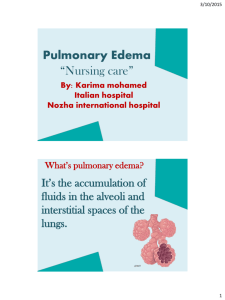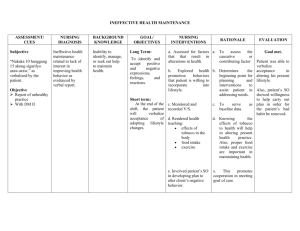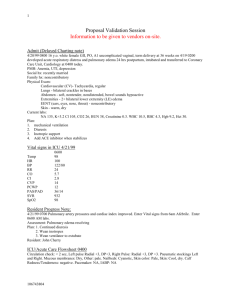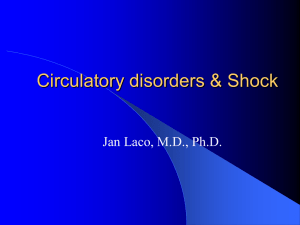Fluid and Hemodynamic Disorders
advertisement
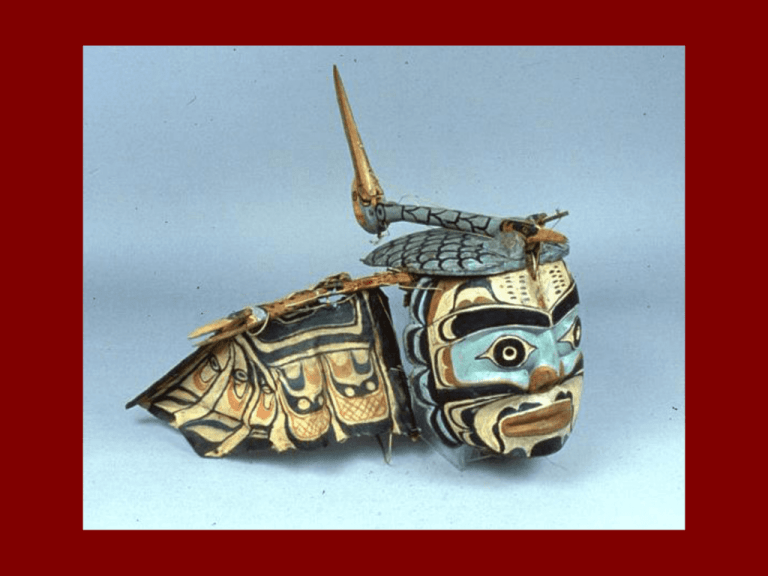
Fluid and Hemodynamic Disorders Where’s my water? • Intracellular • Ions • Ion specific gates in cell membrane • Cellular proteins • Extracellular • Interstitial (between the cells) Lymph • Intravascular • Blood • Lymphatic fluid Movement of water in the vascular system • Hydrostatic, the pumping pressure • Heart • Skeletal muscle action • Oncotic or osmotic, holds fluid in. • Proteins such as albumin • Cellular elements such as RBCs Intracellular & Extracellular Water Things can go wrong • • • • • • Heart failure Kidney failure Myocardial infarction Pulmonary emobolus Tissue congestion Edema Edema • Too much extracellular fluid. – Swelling • tumor – Localized or – Generalized – Dependent • action of gravity Tansudate or Exudate? • Exudate – Inflammatory water – Part of the inflammatory reaction • Rubor, dolor, calor, tumor – Purposeful and intentional – Localized Tansudate or Exudate? • Transudate – Leakage, not part of healing – Increased hydrostatic pressure • Heart failure • Lymphatic obstruction – Decreased oncotic pressure • Decreased albumin Congestive Heart Failure Congestive Heart Failure Passive Congestion Chronic Passive Congestion, Nutmeg Liver Chronic Passive Congestion Pulmonary Edema Pulmonary Edema Pulmonary Edema Pitting Edema Lymphedema Papilledema Water in Hollow Spaces • Hydrothorax • Hydropericardium • Hydroperitoneum – Ascites Healthy Blood Clotting • Platelets • Vessels • Clotting Proteins Healthy Clotting Clotting Factors Factor Activation Hematoma Petechiae Thrombosis • A pathological clot • A clot forming in the fixed vascular system. Thrombosis 1. Endothelial damage 2. Stasis and clotting factor activation 3. Clotting factor abnormalities – Too many clotting proteins • • Pregnancy Cancers – Too little inhibition – Abnormal factors • Leiden Factor (abnormal V) Thrombosis Thrombosis • Arterial Side Thrombi – Platelet activation – Endothelial cell injury • Venous Side Thrombi – Stasis – Clotting factor activation – Endothelial cell injury Coronary Artery Thombosis • Angiogram Acute Myocardial Infarction Mural Thrombus Aneurysm with Thrombus Deep Leg Vein Thrombosis Airplane Travel • Gunner turret Outcomes of a DVT Embolus • Space occupying mass moving in the fixed vascular system • • • • Blood clot Bone Fragments Amniotic Fluid Air Pulmonary Embolus Pulmonary Embolus Infarction • Anemic – End artery supply – No blood – White • Hemorrhagic – Venous occlusion – Loose tissues – Dual blood supply – Red Anemic Infarct Anemic Infarct Cerebral Infarction Hemorrhagic Infarct Shock • • • • Poor perfusion Tissue hypoxia Tissue acidosis Many causes – – – – Poor pumping by heart Low blood volume Loss of fluid Overwhelming infections Types of Shock • Cardiogenic – Decreased output • Hypovolemic – Blood loss – Fluid loss • Anaphylaxis – IgE and histamine • Septic – Gram negative rods – Toxins What Happens Next? • Compensated – Fluid shifts • Decompensated – Progression possible • Irreversible – No recovery The Shock Spiral Summary • Fluid shifts • Oncotic & Hydrostatic Pressures • Excessive tissue water • Exudate vs. Transudate • Clot formation • Vessels, platelets & proteins • Thrombosis • Pathological clot • Arterial = endothelial damage & platelet activation. • Venous = stasis and factor activation Summary • Infarction • Ischemic = end artery organ • Hemorrhagic = venous or dual blood supply • Tissue vulnerability – Brain – Kidney – muscle


